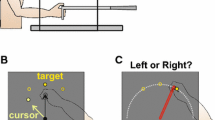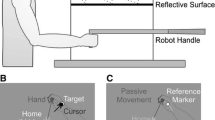Abstract
Reaching movements are rapidly adapted following training with rotated visual feedback of the hand. Our laboratory has also found that this visuomotor adaptation results in changes in estimates of felt hand position (proprioceptive recalibration) in the direction of the visuomotor distortion (Cressman and Henriques in J Neurophysiol 102:3505–3518, 2009; Cressman et al. in Exp Brain Res 205:533–544, 2010). In the current study, we investigated proprioceptive acuity and proprioceptive recalibration in a group of individuals with Ehlers–Danlos syndrome (EDS), a degenerative condition associated with collagen malformation. Some studies have suggested that these patients may have proprioceptive impairments, but the exact nature of the impairment is unclear (Rombaut et al. in Clin Rheumatol 29:289–295, 2010a). In this study, we measured the ability of EDS patients to estimate their felt hand position and tested whether these estimates changed following visuomotor adaptation. We found EDS patients were less precise in estimating their felt hand position in the peripheral workspace compared to healthy controls. Despite this poorer sensitivity, they recalibrated hand proprioception to the same extent as healthy controls. This is consistent with other populations who experience proprioceptive deficits (e.g. the elderly, Parkinson’s disease patients), suggesting that sensory noise does not influence the extent of either motor or sensory plasticity.







Similar content being viewed by others
References
Anguera JA, Reuter-Lorenz PA, Willingham DT, Seidler RD (2011) Failure to engage spatial working memory contributes to age-related declines in visuomotor learning. J Cogn Neurosci 23:11–25
Beighton P, de Paepe A, Danks D, Finidori G, Gedde-Dahl T, Goodman R, Hall JG, Hollister DW, Horton W, McKusick VA (1988) International nosology of heritable disorders of connective tissue, Berlin, 1986. Am J Med Genet 29:581–594
Beighton P, De Paepe A, Hall JG, Hollister DW, Pope FM, Pyeritz RE, Steinmann B, Tsipouras P (1992) Molecular nosology of heritable disorders of connective tissue. Am J Med Genet 42:431–448
Beighton P, De Paepe A, Steinmann B, Tsipouras P, Wenstrup RJ (1997) Ehlers–Danlos syndromes: revised nosology, Villefranche, 1997. Ehlers–Danlos National Foundation (USA) and Ehlers–Danlos Support Group (UK). Am J Med Genet 77:31–37
Bernier PM, Chua R, Bard C, Franks IM (2006) Updating of an internal model without proprioception: a deafferentation study. Neuroreport 17:1421–1425
Bock O (2005) Components of sensorimotor adaptation in young and elderly subjects. Exp Brain Res 160:259–263
Bock O, Girgenrath M (2006) Relationship between sensorimotor adaptation and cognitive functions in younger and older subjects. Exp Brain Res 169:400–406
Buch ER, Young S, Contreras-Vidal JL (2003) Visuomotor adaptation in normal aging. Learn Mem 10:55–63
Castori M (2012) Ehlers-danlos syndrome, hypermobility type: an underdiagnosed hereditary connective tissue disorder with mucocutaneous, articular, and systemic manifestations. ISRN Derm 2012:1–22
Celletti C, Castori M, Galli M, Rigoldi C, Grammatico P, Albertini G, Camerota F (2011) Evaluation of balance and improvement of proprioception by repetitive muscle vibration in a 15-year-old girl with joint hypermobility syndrome. Arthritis Care Res (Hoboken) 63:775–779
Cressman EK, Henriques DYP (2009) Sensory recalibration of hand position following visuomotor adaptation. J Neurophysiol 102:3505–3518
Cressman EK, Salomonczyk D, Henriques DYP (2010) Visuomotor adaptation and proprioceptive recalibration in older adults. Exp Brain Res 205:533–544
De Paepe A, Malfait F (2004) Bleeding and bruising in patients with Ehlers–Danlos syndrome and other collagen vascular disorders. Br J Haematol 127:491–500
Fatoye F, Palmer S, Macmillan F, Rowe P, van der Linden M (2009) Proprioception and muscle torque deficits in children with hypermobility syndrome. Rheumatology (Oxford) 48:152–157
Goble DJ, Coxon JP, Wenderoth N, Van Impe A, Swinnen SP (2009) Proprioceptive sensibility in the elderly: degeneration, functional consequences and plastic-adaptive processes. Neurosci Biobehav Rev 33:271–278
Hall MG, Ferrell WR, Sturrock RD, Hamblen DL, Baxendale RH (1995) The effect of the hypermobility syndrome on knee joint proprioception. Br J Rheumatol 34:121–125
Henriques DY, Soechting JF (2003) Bias and sensitivity in the haptic perception of geometry. Exp Brain Res 150:95–108
Hollister DW (1978) Heritable disorders of connective tissue: Ehlers–Danlos syndrome. Pediatr Clin North Am 25:575–591
Ingram HA, van Donkelaar P, Cole J, Vercher JL, Gauthier GM, Miall RC (2000) The role of proprioception and attention in a visuomotor adaptation task. Exp Brain Res 132:114–126
Izawa J, Criscimagna-Hemminger SE, Shadmehr R (2012) Cerebellar contributions to reach adaptation and learning sensory consequences of action. J Neurosci 32:4230–4239
Jeremiah HM, Alexander CM (2010) Do hypermobile subjects without pain have alteration to the feedback mechanisms controlling the shoulder girdle? Musculoskelet Care 8:157–163
Keer R, Grahame R (2003) Hypermobility syndrome: recognition and management for physiotherapists. Butterworth-Heinemann, New York
Kesten H (1958) Accelerated stochastic approximation. Ann Math Stat 29:41–59
Lawrence EJ (2005) The clinical presentation of Ehlers–Danlos syndrome. Adv Neonatal Care 5:301–314
Malfait F, Wenstrup RJ, De Paepe A (2010) Clinical and genetic aspects of Ehlers–Danlos syndrome, classic type. Genet Med 12:597–605
Parapia LA, Jackson C (2008) Ehlers–Danlos syndrome—a historical review. Br J Haematol 141:32–35
Rombaut L, De Paepe A, Malfait F, Cools A, Calders P (2010a) Joint position sense and vibratory perception sense in patients with Ehlers–Danlos syndrome type III (hypermobility type). Clin Rheumatol 29:289–295
Rombaut L, Malfait F, Cools A, De Paepe A, Calders P (2010b) Musculoskeletal complaints, physical activity and health-related quality of life among patients with the Ehlers–Danlos syndrome hypermobility type. Disabil Rehabil 32:1339–1345
Sacheti A, Szemere J, Bernstein B, Tafas T, Schechter N, Tsipouras P (1997) Chronic pain is a manifestation of the Ehlers–Danlos syndrome. J Pain Symptom Manag 14:88–93
Sahin N, Baskent A, Cakmak A, Salli A, Ugurlu H, Berker E (2008) Evaluation of knee proprioception and effects of proprioception exercise in patients with benign joint hypermobility syndrome. Rheumatol Int 28:995–1000
Salomonczyk D, Cressman EK, Henriques DY (2011) Proprioceptive recalibration following prolonged training and increasing distortions in visuomotor adaptation. Neuropsychologia 49:3053–3062
Seidler RD (2006) Differential effects of age on sequence learning and sensorimotor adaptation. Brain Res Bull 70:337–346
Synofzik M, Lindner A, Thier P (2008) The cerebellum updates predictions about the visual consequences of one’s behavior. Curr Biol 18:814–818
Tinkle BT, Bird HA, Grahame R, Lavallee M, Levy HP, Sillence D (2009) The lack of clinical distinction between the hypermobility type of Ehlers–Danlos syndrome and the joint hypermobility syndrome (a.k.a. hypermobility syndrome). Am J Med Genet A 149A:2368–2370
Treutwein B (1995) Adaptive psychophysical procedures. Vision Res 35:2503–2522
Voermans NC, Knoop H (2011) Both pain and fatigue are important possible determinants of disability in patients with the Ehlers–Danlos syndrome hypermobility type. Disabil Rehabil 33:706–707
Acknowledgments
Special thanks to each of the patients who participated in this study, as well as the Ehlers–Danlos Syndrome Ontario Support Group for promoting awareness of this project. This work has been funded by an NSERC Discovery Grant to DYPH.
Author information
Authors and Affiliations
Corresponding author
Rights and permissions
About this article
Cite this article
Clayton, H.A., Cressman, E.K. & Henriques, D.Y.P. Proprioceptive sensitivity in Ehlers–Danlos syndrome patients . Exp Brain Res 230, 311–321 (2013). https://doi.org/10.1007/s00221-013-3656-4
Received:
Accepted:
Published:
Issue Date:
DOI: https://doi.org/10.1007/s00221-013-3656-4




